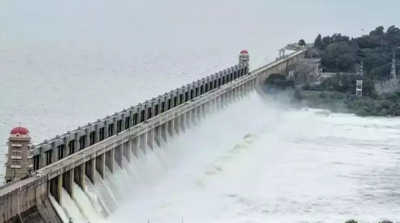ARTICLE AD BOX

The Tunga Bhadra (TB) reservoir in Vijayanagar district accumulated 31.61 TMC of silt, the highest in the state.
BENGALURU: Unlike in previous years, this year’s bountiful monsoon brought much-needed relief across Karnataka. However, the cheer is overshadowed by a worrying trend—the shrinking storage capacity of the state’s major reservoirs due to heavy siltation.
A recent analysis by the Water Resources Department revealed that, on average, the water storage capacity of Karnataka’s 10 major dams reduced by 12.49%, with individual reductions ranging from 4% to 28% depending on silt accumulation.While some reservoirs are silting up slowly, others are losing capacity at an alarming rate. This poses serious challenges for agriculture, horticulture, power generation, and industrial activity.
Although national standards allow up to 3% silt accumulation of a reservoir’s overall capacity, several dams are already nearing or have crossed this threshold. Experts warn that climate change and erratic rainfall patterns, which accelerate soil erosion in catchment areas, could further push silt levels to dangerous limits, jeopardising Karnataka’s water security.Tunga Bhadra & Basava Sagar worst affected
According to the department’s data, the Tunga Bhadra (TB) reservoir in Vijayanagar district accumulated 31.61 TMC of silt, the highest in the state. The Basava Sagar (Narayanpur) dam in Yadgir district follows with 10.55 TMC.
In terms of capacity loss, however, Basava Sagar suffered the most, with a 28% reduction, followed by the TB dam with 24%. “Unlike the TB dam, which is nearly 75 years old (built in 1950), Basava Sagar was constructed only in 1982. Yet it is fast losing its capacity due to the alarming pace of siltation. This situation only benefits lower riparian states, as excess water flows downstream at the cost of our farmers,” explained a retired Water Resources Department official.Govt needs 73,000 acres to dump siltThe scale of the problem is staggering. A senior department engineer explained, “The TB dam, which stretches 21 km from north to south, receives about 0.42 TMC of silt annually. Over the last 70 years, it accumulated nearly 32 TMC—almost equal to the full storage capacity of the Krishna Raja Sagar (KRS) dam! If we attempt to desilt it and dump the silt in 10-foot-high mounds, we would require 73,462 acres of land. Even with 1,000 tractors removing one TMC of silt per day, the task is unviable.
”In 2017, farmer groups attempted a community-driven desilting effort, deploying 125 tractors, 15 tippers, and 10 backhoes for two weeks. They managed to remove 0.75 TMC of silt, spending about ₹15 lakh on diesel and food. The silt was dumped on farms within a 10 km radius of Vijayanagar and Koppal. However, no such initiatives have been taken up since. The state proposed to the Centre the removal of 26 TMC of silt at a cost of ₹13,695 crore, but the proposal remains stuck at the correspondence stage.
Meanwhile, Karnataka is awaiting approval from Andhra Pradesh and Telangana to build a balancing reservoir at Navali.Harangi dam the only one being desiltedCurrently, the only active desilting work is at the Harangi dam in the Cauvery basin. “The govt has taken up a project to remove 0.031 TMC of the 1.23 TMC of accumulated silt at a cost of ₹39 crore. Work is being carried out at the confluence point at the rear of the reservoir,” said an engineer from Cauvery Neeravari Nigam (CNN) Limited.Increase forest coverEcologists and engineers have blamed reckless development activities in the catchment areas and rampant degradation of land. "The land use pattern in almost all catchment areas has undergone a sea change with alarming reduction in green cover. There is nothing that binds and holds the soil during the heavy downpour. The eroded soil gets washed away in the river and eventually gets deposited in the reservoirs. The only solution to prevent this is to increase green cover in the catchment, especially along the river banks and streams, along with large-scale afforestation activities and round-the-clock monitoring of such afforested areas to reduce soil erosion and prevent further accumulation of silt," explained a scientist from the Indian Institute of Science (IISc).



.png)
.png)
.png)
















 2 hours ago
3
2 hours ago
3









 English (US) ·
English (US) ·